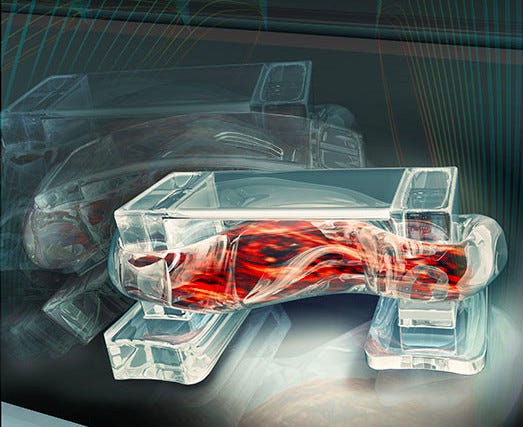July 2, 2014
In 2012, scientists at the University of Illinois at Urbana-Champaign created a walking biological robot powered by cells from the heart. The heart cells proved capable of generating movement in the small bio-bots (measuring less than a centimeter in height), but controlling the bot proved difficult as the cells are programmed to beat continuously. In addition, it was difficult to turn those robots on or off.
To overcome those limitations, researchers at the same university have developed muscle-controlled walking soft robotic devices controlled by skeletal muscle that is controlled by pulse of electricity. The advance enabled the scientists to precisely control the movement of the robots, which were modeled after the muscle-tendon-bone complex found in many animals. In addition to producing force, the robots are also capable of sensing and processing signals from their environment. The bio-bots are also said to be cost effective compared to similar robots made with rigid materials such as metals.
|
Bio-bots use skeletal muscle cells for locomotion. Image courtesy Janet Sinn-Hanlon, Design Group@VetMed. |
Potential applications of the bio-bots include medical technology as well as environmental clean-up uses. Examples of potential medical applications include drug-screening and delivery, programmable tissue engineering, and biomimetic machine design.
The researchers created the robots by integrating flexible 3-D printed hydrogel and engineered muscle. The hydrogel contains an extra cellular matrix consisting of collagen and fibrin matrix proteins and an insulin-like growth factor.
The use of stereolithographic 3-D printing has the advantages of offering scalability as well as being quick and precise.
The hydrogel is printed into a shape roughly resembling a coffee table with a thick strand of muscle connecting its legs. When the muscle flexes, the entire apparatus dragging it forward in an inchworm-like manner. The maximum speed reached by the bio-bots was approximately 156 ?m s-1, which translates to more than 1.5 body lengths per min.
|
The speed of the bio-bot can be controlled by modifying the frequency of its electrical field. |
Spearheaded by professor Rashid Bashir, who is the head of bioengineering at the university, the research project holds promise in that it could pave the way towards the development of robots that can be paced with external signals. "For example, you would use skeletal muscle when designing a device that you wanted to start functioning when it senses a chemical or when it received a certain signal," Bashir explained in a statement. "To us, it's part of a design toolbox. We want to have different options that could be used by engineers to design these things."
Refresh your medical device industry knowledge at MEDevice San Diego, September 10-11, 2014. |
The researchers are taking advantage of the flexibility afforded by 3-D printing to explore a variety of bio-bot designs. They note that this research advance could potentially lead to the development of more-complex living cellular robots that feature skeletal muscle interfacing with other mammalian cells, including neurons and endothelial cells.
Brian Buntz is the editor-in-chief of MPMN and Qmed. Follow him on Twitter at @brian_buntz.
Like what you're reading? Subscribe to our daily e-newsletter.
About the Author(s)
You May Also Like




